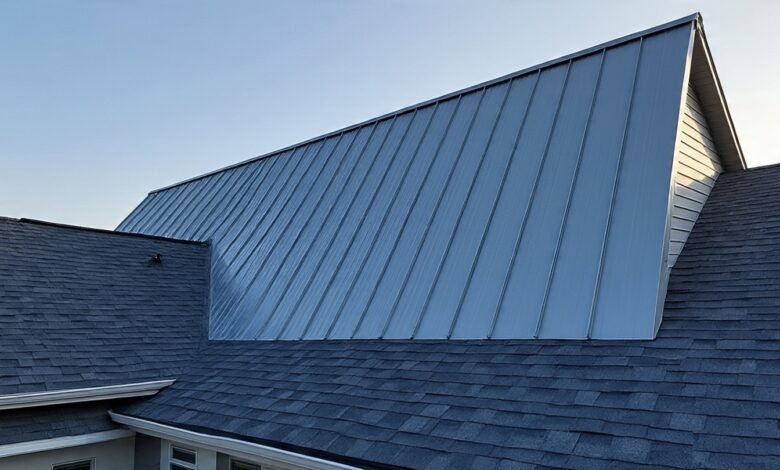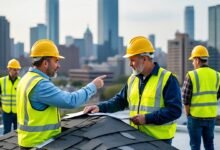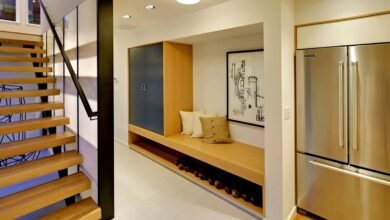Roofing Trends in USA: 20 Game-Changing Trends Reshaping American Homes in 2025
Discover the top roofing trends transforming American homes in 2025. From sustainable materials to smart technology - your complete guide to modern roofing.

The roofing industry in the United States is experiencing unprecedented transformation as we advance through 2025. From cutting-edge sustainable roofing materials to revolutionary smart roofing technology, American homeowners are embracing innovations that promise enhanced durability, energy efficiency, and aesthetic appeal. This comprehensive guide explores the top 20 roofing trends that are defining the landscape of residential roofing across the nation.
The modern American homeowner’s priorities have evolved significantly, driven by climate consciousness, technological advancement, and changing lifestyle needs. Today’s roofing solutions must address multiple challenges simultaneously: extreme weather resistance, energy conservation, environmental sustainability, and long-term cost effectiveness. These shifting demands have catalyzed a wave of innovation in roofing materials, installation techniques, and maintenance approaches.
Understanding these roofing trends is crucial for homeowners planning roof replacements, contractors seeking competitive advantages, and industry professionals aiming to stay ahead of market demands. The trends we’ll explore range from eco-friendly materials that reduce carbon footprints to intelligent systems that monitor roof health in real-time, representing a fundamental shift toward smarter, more sustainable roofing practices.
1. Solar-Integrated Roofing Systems
Solar roofing has evolved from bulky panel installations to seamlessly integrated systems that blend functionality with aesthetics. Tesla’s Solar Roof and similar products are revolutionizing how Americans think about energy-efficient roofing. These systems incorporate photovoltaic cells directly into roofing materials, creating a unified appearance while generating renewable energy.
The integration of solar technology into traditional roofing materials offers homeowners the dual benefit of roof protection and energy production. Modern solar shingles are designed to withstand harsh weather conditions while maintaining the visual appeal of conventional roofing materials. This trend is particularly strong in states with favorable solar incentives and high electricity costs.
Solar-integrated roofing systems typically offer 20-25 year warranties and can significantly reduce or eliminate electricity bills. The technology has advanced to the point where solar cells can be incorporated into various roofing materials, including asphalt shingles, metal panels, and clay tiles, making this trend accessible across diverse architectural styles.
2. Cool Roofing Technology
Cool roofing materials are gaining tremendous popularity as Americans seek to reduce cooling costs and urban heat island effects. These specialized materials reflect more sunlight and absorb less heat than standard roofing products, keeping buildings cooler and reducing energy consumption.
The cool roof technology encompasses various approaches, including highly reflective coatings, specialized granules in asphalt shingles, and inherently reflective materials like white membranes and light-colored metals. Energy Star-certified cool roofing products can reduce roof surface temperatures by up to 50-60 degrees Fahrenheit compared to traditional dark-colored roofs.
This roofing trend is particularly significant in southern and western states where cooling costs represent a major portion of energy bills. Many utilities now offer rebates for cool roofing installations, and some building codes are beginning to mandate reflective roofing in certain climates.
3. Living Roofs and Green Technology
Green roofing systems are transforming urban landscapes across America, offering environmental benefits that extend far beyond individual properties. These living roofs incorporate vegetation layers that provide insulation, absorb rainwater, and create habitat for wildlife while reducing building energy consumption.
Extensive green roofs feature shallow growing mediums and low-maintenance plants like sedums and grasses, while intensive systems support deeper soils and more diverse plant communities. Both approaches contribute to stormwater management, air quality improvement, and urban biodiversity enhancement.
The green roofing trend is supported by increasing municipal incentives, LEED certification programs, and growing awareness of environmental benefits. Cities like Chicago, New York, and Portland have implemented policies encouraging green roof installation, making this sustainable option increasingly attractive to environmentally conscious homeowners.
4. Advanced Synthetic Materials
Synthetic roofing materials are revolutionizing the industry with products that mimic traditional materials while offering superior performance characteristics. Modern composite shingles can replicate the appearance of wood, slate, or clay while providing enhanced durability, lighter weight, and reduced maintenance requirements.
Polymer-based roofing products resist impact damage, UV degradation, and moisture infiltration better than many natural materials. These synthetic materials often carry extended warranties and can withstand extreme weather conditions that might damage conventional roofing systems.
The advancement in composite roofing technology has reached the point where synthetic products can be virtually indistinguishable from natural materials, allowing homeowners to achieve desired aesthetic outcomes without compromising on performance or longevity.
5. Smart Roofing Monitoring Systems
Smart roofing technology is introducing unprecedented levels of monitoring and maintenance capability to residential roofing systems. Internet-connected sensors can track moisture levels, temperature variations, structural movement, and potential leak sources in real-time.
These intelligent roofing systems alert homeowners to potential issues before they become major problems, enabling proactive maintenance that extends roof lifespan and prevents costly damage. Some systems integrate with home automation platforms, providing seamless monitoring through smartphone applications.
Smart roof monitoring represents a paradigm shift from reactive to preventive maintenance, potentially saving thousands of dollars in repair costs while ensuring optimal roof performance throughout its lifespan.
6. Impact-Resistant Materials
With extreme weather events becoming more frequent and severe, impact-resistant roofing materials are experiencing surging demand across the United States. These specialized products are designed to withstand hail, wind-blown debris, and other severe weather impacts that can cause significant roof damage.
Class 4 impact-resistant shingles undergo rigorous testing to ensure they can withstand impacts from steel balls dropped at specific velocities, simulating severe hail conditions. Many insurance companies now offer premium discounts for homes with impact-resistant roofing, making these materials financially attractive in addition to their protective benefits.
The impact-resistant trend is particularly strong in regions prone to severe weather, including the Midwest, South, and areas of the Southwest where hailstorms can cause billions of dollars in property damage annually.
7. Metal Roofing Innovation
Metal roofing continues to evolve with new alloys, coatings, and installation techniques that enhance both performance and aesthetics. Modern metal roofing systems offer exceptional longevity, often lasting 50+ years with minimal maintenance requirements.
Advanced coating technologies have expanded color options and improved fade resistance, while new profile designs allow metal roofs to complement various architectural styles. Standing seam systems provide clean, contemporary lines, while textured panels can mimic traditional shingles or tiles.
The metal roofing trend is driven by factors including fire resistance, recyclability, energy efficiency, and long-term cost effectiveness. Many metal roofing products are manufactured from recycled content and are fully recyclable at the end of their service life.
8. Sustainable and Recycled Materials
Environmental consciousness is driving significant growth in sustainable roofing materials made from recycled content. Manufacturers are developing innovative products that incorporate recycled plastics, rubber, and other materials into high-performance roofing systems.
Recycled roofing materials include rubber shingles made from recycled tires, composite products incorporating recycled plastics, and metal roofing manufactured from recycled steel and aluminum. These products often match or exceed the performance of virgin materials while reducing environmental impact.
The sustainable roofing trend aligns with growing consumer demand for environmentally responsible building materials and contributes to LEED certification and other green building programs.
9. Enhanced Weatherproofing Systems
Advanced weatherproofing technologies are providing superior protection against water infiltration and weather-related damage. Modern roofing underlayments incorporate synthetic materials that offer better tear resistance, UV stability, and moisture protection than traditional felt products.
Self-adhering ice and water shields are being used more extensively, not just in problematic areas but across entire roof surfaces in some applications. These materials provide additional protection against wind-driven rain and ice dam formation.
Weatherproofing innovations also include improved flashing systems, better sealants, and more effective ventilation strategies that work together to create comprehensive weather protection systems.
10. Architectural Shingle Evolution
Architectural shingles continue to evolve with new designs, colors, and performance features that enhance both curb appeal and functionality. Modern dimensional shingles offer increasingly sophisticated shadow patterns and color variations that create visual depth and interest.
Advanced granule technologies provide better UV protection, algae resistance, and color retention, while structural improvements enhance wind resistance and durability. Some architectural shingles now incorporate reflective granules for improved energy efficiency.
The architectural shingle trend focuses on creating premium appearances at moderate price points, making high-end aesthetics accessible to a broader range of homeowners.
11. Integrated Gutter Systems
Seamless gutter integration is becoming a key consideration in modern roofing design. Advanced gutter systems that integrate closely with roofing materials provide better water management while enhancing overall aesthetic appeal.
Integrated gutter systems may include hidden hangers, color-matched components, and specialized designs that complement specific roofing materials. Some systems incorporate overflow protection and self-cleaning features that reduce maintenance requirements.
This roofing trend recognizes that effective water management extends beyond the roof surface itself, encompassing the entire water collection and drainage system.
12. Drone-Assisted Inspections
Drone technology is revolutionizing roof inspections, maintenance, and damage assessment. Professional-grade drones equipped with high-resolution cameras and thermal imaging can identify potential problems without requiring physical roof access.
Drone inspections provide detailed documentation of roof conditions, enabling more accurate maintenance planning and insurance claims processing. This technology is particularly valuable for steep or complex roofs where traditional inspection methods pose safety risks.
The drone inspection trend is improving safety while providing more comprehensive and accurate roof assessments than traditional visual inspections.
13. Modular Roofing Systems
Modular roofing approaches are gaining traction as building techniques evolve toward greater prefabrication and standardization. These systems allow for faster installation while maintaining quality and performance standards.
Prefabricated roofing modules can be manufactured in controlled environments and assembled on-site, reducing installation time and weather-related delays. This approach is particularly effective for commercial applications and large residential projects.
The modular trend addresses labor shortages in the construction industry while potentially reducing overall project costs and improving quality control.
14. Fire-Resistant Technologies
With wildfire risks increasing across many regions, fire-resistant roofing materials are becoming essential in vulnerable areas. Class A fire-rated materials provide the highest level of fire resistance and are often required by building codes in high-risk zones.
Fire-resistant roofing systems incorporate materials and designs that resist ignition from flying embers and radiant heat. These may include specialized underlayments, ember-resistant vents, and materials that char rather than ignite when exposed to high temperatures.
The fire-resistant trend is particularly strong in western states where wildfire risks have increased significantly in recent years.
15. Advanced Insulation Integration
Integrated insulation systems that combine roofing and insulation installation are improving energy efficiency while streamlining construction processes. These systems may include insulated roof panels or specialized installation techniques that eliminate thermal bridging.
Roof insulation innovation focuses on achieving higher R-values with thinner profiles, allowing for better energy performance without compromising interior space. Some systems integrate vapor barriers and air sealing into the roofing installation process.
This insulation trend addresses increasing energy efficiency requirements while simplifying construction details and improving overall building performance.
16. Customizable Color Systems
Color customization in roofing materials is expanding dramatically, with manufacturers offering extensive color palettes and even custom color matching services. Advanced coating technologies enable more vibrant and durable colors than ever before.
Custom roofing colors allow homeowners to achieve specific aesthetic goals and coordinate with other exterior elements. Some manufacturers offer virtual design tools that help visualize different color combinations before making final selections.
The color customization trend reflects increasing demand for personalization in home design and the desire to create unique exterior appearances.
17. Maintenance-Free Solutions
Low-maintenance roofing systems are addressing homeowner desires to minimize ongoing upkeep requirements. These solutions may include self-cleaning surfaces, algae-resistant treatments, and materials that naturally shed debris.
Maintenance-free technologies also encompass gutter protection systems, moss-resistant treatments, and materials that don’t require periodic sealing or coating. The goal is to provide long-term performance with minimal homeowner intervention.
This low-maintenance trend appeals to busy homeowners and aging populations who prefer systems that function reliably without regular attention.
18. Ventilation System Advances
Advanced roof ventilation systems are becoming more sophisticated, with powered options, smart controls, and more effective air movement designs. Proper ventilation is crucial for preventing moisture problems and maintaining energy efficiency.
Ventilation innovations include solar-powered exhaust fans, humidity-controlled ventilation systems, and ridge vents with enhanced airflow characteristics. These systems work to maintain optimal attic conditions regardless of weather conditions.
The ventilation trend recognizes that roof systems must manage not just water but also air movement to prevent moisture-related problems and maintain energy efficiency.
19. Installation Technology Improvements
Roofing installation technology is evolving with new tools, techniques, and safety equipment that improve both quality and efficiency. Pneumatic nailers, automated shingle applicators, and safety systems are making installation faster and more reliable.
Installation innovations also include better fasteners, improved sealants, and techniques that enhance long-term performance. Training programs and certification systems are ensuring that new technologies are properly implemented.
This installation trend addresses skilled labor shortages while improving the quality and consistency of roofing installations across the industry.
20. Warranty and Service Evolution
Extended warranty programs and comprehensive service packages are becoming standard offerings from roofing manufacturers and contractors. These programs provide greater peace of mind while protecting homeowner investments.
Warranty innovations may include transferable warranties, performance guarantees, and comprehensive coverage that includes both materials and labor. Some programs offer proactive maintenance services and priority repair responses.
The warranty trend reflects industry maturation and increased confidence in product performance, while providing value-added services that differentiate premium offerings.
Conclusion: The Future of American Roofing
The roofing industry in 2025 represents a convergence of sustainability, technology, and performance that is fundamentally reshaping how Americans approach roof systems. These 20 roofing trends demonstrate an industry that is responding to climate change, technological advancement, and evolving homeowner expectations.
Sustainable roofing materials, smart technology integration, and advanced weatherproofing are no longer luxury options but are becoming standard expectations. The trends toward energy efficiency, environmental responsibility, and long-term performance reflect broader societal shifts that are likely to continue driving innovation.
For homeowners considering roof replacement or new construction, understanding these roofing trends is essential for making informed decisions that will provide long-term value and satisfaction. The investment in modern roofing systems that incorporate these innovations can provide decades of superior performance while contributing to environmental sustainability and energy independence.
The future of roofing promises continued innovation as manufacturers respond to changing climate conditions, advancing technology, and evolving consumer preferences. By staying informed about these trends, homeowners can make choices that position their properties for optimal performance in an increasingly complex and demanding environment.











